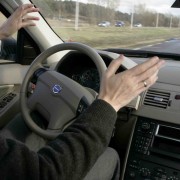Burney Simpson
Autonomous vehicles would be developed faster if federal rules could preempt state laws on the technology, the Washington, D.C-based advocacy group SAFE argued last week.
The not-for-profit Securing America’s Future Energy released its The National Strategy for Energy Security: The Innovation Revolution paper, a 160-page pdf listing a host of new approaches to powering transportation, at a series of presentations at the Newseum.
The report calls for the federal pre-emption of state autonomous vehicle regulations, the start of live testing of the vehicles in select communities, and an office at the Department of Transportation to lead development of the technology.
“We need uniformity and consistency of regulations across all 50 states so autonomous vehicles can be developed,” said Amitai Bin-Nun, director of Safe’s Autonomous Vehicle Initiative.
![ElectricCharge1]() Safe was joined at its event by John Krafcik, chief of Google parent Alphabet’s self-driving cars group, along with executives from Nvidia, producer of graphic processing units; Peloton, groundbreaker in truck platooning research; and Moovel, Daimler’s urban mobility operator.
Safe was joined at its event by John Krafcik, chief of Google parent Alphabet’s self-driving cars group, along with executives from Nvidia, producer of graphic processing units; Peloton, groundbreaker in truck platooning research; and Moovel, Daimler’s urban mobility operator.
Safe advocates for America’s energy security, arguing the country’s transportation sector is too dependent on foreign oil. Instead, the “widespread adoption of plug-in electric vehicles would put an end to oil’s stranglehold on the U.S. transportation system,” according to its website.
Safe’s Energy Security Leadership Council is led by Frederick Smith, president and CEO of FedEx Corp., and General James Conway, a retired Marine Corps Commandant.
Safe has set a goal of reducing oil demand by 50 percent by 2040, and autonomous vehicles are central to that objective, Conway said.
“I would argue that we probably don’t get there unless the autonomous vehicle movement succeeds and becomes our mainstay,” said Conway, according to Safe’s The Verge news source.
Safe’s national strategy paper comes amidst a contentious debate over driverless regulations in California, a leading autonomous vehicle center.
Last December the state’s Department of Motor Vehicles floated the idea of requiring drivers physically sitting behind steering wheels in driverless cars. Google responded the proposal failed to understand the point of the vehicles, and didn’t recognize the capabilities of the technology.
Soon thereafter, the National Highway Traffic Safety Administration (NHTSA) pledged to release this summer guidelines for the states on autonomous vehicles.
Since then, the California State Legislature has considered several proposals that sought to limit the authority of the state DMV.
THREE REG CHANNELS
Most states haven’t taken a hard look of driverless technology. As of April, eight states and the District of Columbia are either allowing testing of the technology on their roads, or are conducting research on the topic, according to the National Conference of State Legislatures.
“We don’t know where states will wind up. They might include (requirements) for a driver and a steering wheel,” said Bin-Nun. “Designing a vehicle for different states is very difficult for the auto OEMs.”
Safe believes driverless oversight should be organized in three channels, said Bin-Nun.
First, regulations on vehicle hardware should continue to be set at the federal level, while states should continue to control local licensing, insurance, traffic laws, and driver-for-hire rules, he said.
Third, a federal office should regulate autonomous vehicle safety rules, said Bin-Nun.
Safe last year created its autonomous vehicle task force and ramped up its promotion of electric-engine equipped autonomous vehicles (See “Autonomous Cars = Lower Oil Imports”). Bin-Nun became director of the department in February.
A shift to electric-powered vehicles would reduce the use of gas-powered internal-combustion engine (ICE) vehicles.
In contrast, electric vehicles get charged by power supplied by the electric power industry. Domestic energy sources coal, natural gas, nuclear plants, hydro plants, and wind and solar provide the fuel for electric utilities, according a study from The Washington Post.
Photos: Electric car reloading/recharging, 2011, by Ludovic Hirlimann; Foto e vide di tutti I modelli, 2015, by Automobile Italia.

